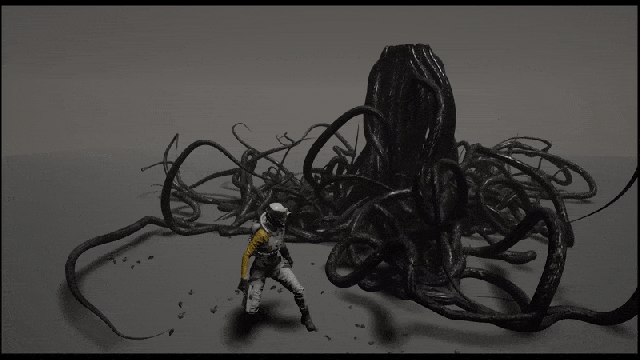Returnal, the PlayStation 5 time loop game that isn’t the one everyone’s talking about this week, might seem like it’s about escaping a temporally out-of-whack exoplanet. But really, it’s about getting your lunch money repeatedly stolen by malevolent tentacle monsters. Much of the game’s unsettling vibe comes from local fauna — the abyssal monstrosities with squid arms for teeth and bioluminescent blue tendrils that indicate how not-on-Earth you are.
Over on PlayStation Blog this morning, Housemarque’s Risto Jankkila and Sharman Jagadeesan detailed how it approached Returnal’s nightmarish “tentacle tech” (and, sure, other visual effects). It’s a lot of jargon, but fans of the game will no doubt get a kick out of a behind-the-scenes look at some of the most visually arresting special effects to run on PS5 to date. But the coolest stuff is the peek at how Housemarque applied its signature particle tech to enemy tentacles.
Housemarque, which was acquired by Sony following Returnal’s runaway success, made a name for itself by developing games with eye-popping particle effects. A form of the proprietary tech that first showed up in 2013’s PS4 launch title Resogun has since morphed into what the developer calls “Next Gen Particle System,” or NGP. You can see its DNA in some of the studio’s subsequent games, like Nex Machina or Matterfall.
Particle effects are present in Returnal — nearly every class of enemy, from cannon fodder to the punishing biome bosses, fires a ceaseless barrage of iridescent death orbs your way — as well. But Housemarque applied the same tech to the tentacles that define those enemies as well.
Read More: Why The Rain In Returnal Feels So Damn Good
At first, the developer tried to design Returnal’s terrifying tendrils the “traditional” way: by simulating the way bones work IRL and governing them by IRL physics. That proved too taxing, however. Despite the PS5’s significant computational horsepower, the “performance cost” of creating a bunch of those tentacle groups was “too high.”
As a workaround, Housemarque fell back on its trusty particle tech — specifically on what the studio calls “node particles,” which were initially designed to render otherworldly plants and such. These nodes are made up of unidirectional pathways that can generate some seriously realistic-looking flora and could easily be applied to biological creatures as well. Here’s Jankkila and Jagadeesan explaining how it:
This particle type allows us to create one-directional, parent-child connections. A particle can be a parent to multiple children, but a particle can have only one parent. When reading the parent particle, the parent data is one frame old, i.e., not the data that is being written to in the current frame. This makes it impossible to ‘follow’ the parent strictly and results in a side effect that makes the motion of the particles appear ‘organic.’ This side effect is used widely in particle effects in Returnal, and it was especially useful for things like tentacles.
Initially, Housemarque tried to render those tentacles out of traditional polygons, but that left out some crucial visual effects, like shadows. Instead, when the team decided to use NGP — which uses cylindrical meshes and is less of a CPU strain — it clicked. No longer was the team bound by the pesky rules of physics. Instead, they could essentially tell these tentacles what to do based on an enemy’s action. So if, say, a titanops was about to leap at you, its tendrils could pulse red and flare like a fireworks show.
All of this is in line with Housemarque’s stated intention to “simulate as much as possible during runtime,” rather than using “pre-baked data.” Now, consider that Returnal cold boots — the time from clicking on the icon to playing the game — in about 15 seconds.
Impressive stuff. Clearly, a lot of work went into giving me nightmares for the rest of forever. Still no word on the game’s actually biggest scare, though: its lack of a save-and-quit feature.

Leave a Reply